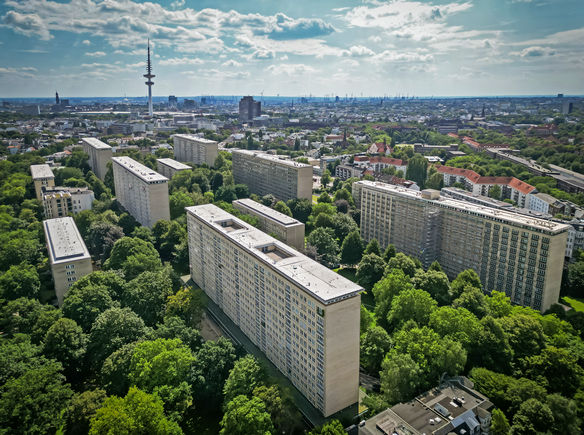Sustainability building renovation under historical preservation requirements: double casement windows as a customised window solution for the Grindel tower blocks
After an extensive building renovation, the listed high-rise building at Oberstrasse 14b in Hamburg's Grindel district is now ready for a long service life as a modern commercial property. GEZE window drives in a double casement window with an integrated shading system now provide fresh air and user comfort.
A mammoth project: the building renovation of the Grindel tower blocks
One central aspect of the building renovation of the high-rise building at Oberstrasse 14b was updating the windows and heating surfaces in the building. At the same time, sun protection and ventilation comfort for building users needed to be improved, so that the listed building could be used in a contemporary way with computer workstations. However, historical preservation requirements for the building had to be taken into account, which demanded creative solutions.
What are the key considerations for building renovations under historical preservation requirements?

Sören Eilers, Specification Sales Manager at GEZE, supported the building renovation with his expertise in developing window solutions for modern living comfort. © Jürgen Biniasch / GEZE GmbH
The following requirements must be observed for windows during building renovations of listed buildings such as the Grindel tower blocks:
- Historic window shapes and materials must be preserved. Unavoidable changes, colouring and surface treatments should correspond to the historical appearance and not impair the original design.
- Windows may only be replaced if they are irreparable. Repairs and restorations should be prioritised.
- Energy aspects such as sufficient insulation must be harmonised with the requirements of historical preservation.
Important note: The approval of the monument protection authority is required for all changes to listed windows. Because of this, it is a good idea to get in contact with the relevant monument protection authority at an early stage to clarify specific requirements and guidelines.
The renovation of this historic building required not only technical expertise, but also careful coordination – so that all project partners can work closely together. The client's aim was to integrate innovative window solutions that preserve the charm of the tower blocks, while offering modern living comfort.
Sören Eilers, Specification Sales Manager / Deputy Branch Officer at GEZE NordDouble casement windows as an innovative window solution that complies with historical preservation requirements

Sören Eilers from GEZE and architect Martin Muus worked closely with the window and glass manufacturer during the planning process. © Jürgen Biniasch / GEZE GmbH
Replacing the windows was unavoidable in order to improve the shading and ventilation concept and at the same time improve thermal insulation in summer and winter, sound proofing and user and working comfort. Under historical preservation requirements, the external appearance could not be changed, not even by sun protection. The idea: One of the oldest and most proven window types, the casement window, was reinterpreted by the architects Dipl. Ing. Muus and Dipl. Ing. Wilde, who were in charge of the project.
To solve these challenges, the architects worked closely with window manufacturer Sehlmann Fensterbau GmbH, glass manufacturer Semcoglas Holding GmbH and the window drive specialists from EMT and GEZE at an early stage of the project – true to the motto "Achieving more together".
Commitment and open communication with everyone involved enabled us to recognise challenges at an early stage and develop solutions together. This close and very cooperative partnership helped ensure the project went smoothly.
Architects Dipl.-Ing. Muus and Dipl.-Ing. Wilde, MUUS & WILDE Architektenpartnerschaft HamburgThe solution: modern double casement windows that comply with historical preservation requirements

Dennis Bredahl from Semcoglas Holding GmbH optimised the thermal and sound proofing of the double casement windows with special solar control and thermal insulation glazing. © Jürgen Biniasch / GEZE GmbH
A double casement window consists of two window elements arranged one behind the other and mounted on a common frame. The advantage of this historic window concept: The air space between the two window elements serves as thermal insulation and sound proofing, as the staggered opening of the windows means that sound has to pass through the space between them and is thus significantly attenuated once again, even during ventilation. Our modern casement window solution uses high-quality solar control glass on the outside and thermal insulation glass on the inside, which significantly improves the insulation value and sound proofing – also increasing user comfort in the buildings.
Thanks to the double glazing, double casement windows already offer much higher thermal and sound proofing compared to conventional windows. These properties were significantly improved by the use of high-quality solar control glazing and thermal insulation glass as so-called neutral glass and a special coating (Semco Klimaglas).
Dennis Bredahl, Semcoglas Holding GmbH
Window manufacturers Jan and Lasse Sehlmann implemented customised solutions that combine historical preservation and user requirements. © Jürgen Biniasch / GEZE GmbH
Pleasant indoor climate thanks to integrated shading
The new double casement windows are equipped with an integrated shading system. This consists of automatic composite blinds with 35 mm wide slats that run between the two window frames. This solution makes it possible to keep the rooms cool during the day, while at the same time ensuring natural ventilation through the outer window. The blinds can be operated independently for added convenience. This reduces costs for air conditioners and the offices are naturally ventilated.

Modern casement window at the Grindel tower blocks in Hamburg. © Jürgen Biniasch / GEZE GmbH
Safety and ease of use thanks to modern window drives
For the outer window leaves, GEZE Slimchain drives were installed as a system solution in combination with the Power lock locking drive, which enables simple operation via push buttons in the room. The inner leaves of the double casement windows can still be opened manually. The Power lock locking drive ensures that a reliable lock is guaranteed, especially on the higher storeys, and even under heavy wind loads. As only the outer windows are motorised, no additional protection is required for power-operated windows in accordance with the Machinery Directive 2006/42/EC. The opening drives were integrated into the window frame in a concealed location, and the supply lines were routed in the construction joint.
A unique feature: With their very slim and discreet appearance, the Slimchain window drives integrate perfectly into the structure – so that strict historical protection requirements are met. This means the well-insulated double casement windows with integrated shade control are a modern, comfortable and energy-efficient solution that simultaneously respects the architectural character of the building and complies with the strict historical preservation requirements.
The technical expertise and the rapid involvement of all parties in the planning process enabled us to develop customised solutions that meet both high historical preservation requirements and the needs of building users.
Jan and Lasse Sehlmann, window fitters at Sehlmann Fensterbau GmbHAchieving our goal together: successful project planning and coordination
GEZE was already in close contact with all project participants in the early planning phases, which enabled smooth discussions and effective collaboration. This early involvement of all parties made it possible to identify potential challenges at an early stage and develop solutions together. In addition, GEZE supported project coordination through continuous cooperation with the partner company EMT. Contact with the architect and building services was also maintained during the implementation phase. This ongoing collaboration ensured that all aspects of the project were seamlessly integrated and that the implementation went smoothly.
Modern history: the listed Grindel tower blocks
The Grindel tower blocks in Hamburg's Eimsbüttel district were the first residential tower blocks built in Germany after 1945. They were highly modern and comfortable flats when they were built in the post-war period, and remain so today – with central heating, hot and cold running water and lifts. In addition, the flats are bright and flooded with light thanks to their orientation and windows, while remaining pleasantly shaded in summer. Today, the ensemble of twelve high-rise buildings and a park is historically preserved.
A tip for visitors to Hamburg: in the centre of the Grindel tower blocks is the Eimsbüttel district office, which has become a real tourist attraction with its historic paternoster lift
Comprehensive support throughout the entire project life cycle
Our experts support you throughout the entire project life cycle – from planning and project coordination to the certified assembly and initial acceptance of GEZE systems and regular maintenance, through to retrofitting and dismantling. Please get in touch with us – we will find customised solutions for your project.








